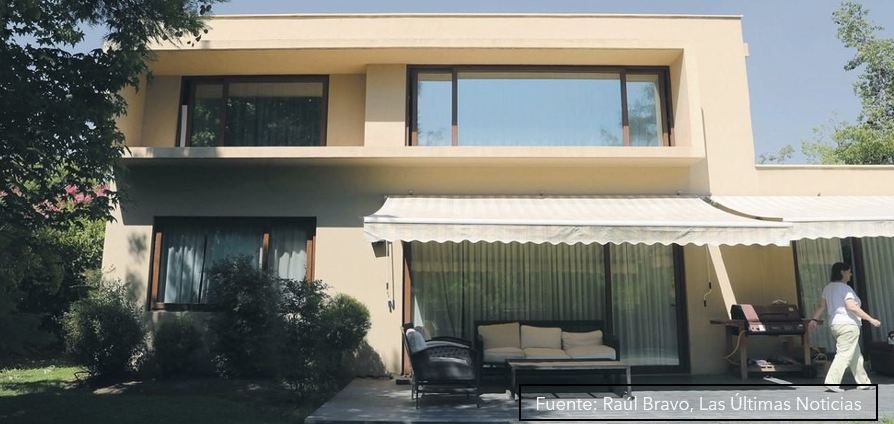This is how the films that adhere to windows work to reduce heat
January 25, 2023
After seeing the temperature change in her office following the installation of solar control films, administrative assistant Soledad Pizarro decided to install them on two large windows in her living room.
“From 12:30 to 5 p.m., the sun was relentless. We had to retreat to the kitchen,” she recalls.
She spent $200,000. Now, she rarely uses the air conditioner and can spend summer afternoons watching movies with her children on the sofa.
Pedro Abarza recalls practically roasting on the second floor of his house in Chicureo, where the master bedroom and his office are located. The indoor thermometer reached up to 34°C. He spent $800,000 to install 12 square meters of film on nearly all the thermopane windows on the second floor and some on the first. He chose a model that blocks 60% of solar energy.
“It took two hours to install the film, which is applied to the inside of the window, and the effect was immediate. The temperature dropped by 5°C to 7°C, and now it’s around 27°C. The house feels much cooler,” he describes.
The films range from completely transparent to polarized, and in winter, they help retain indoor heat.
From the inside, the film is almost invisible, and from the outside, the windows have a very subtle greenish-blue tint, which he doesn’t mind.
Maurizio Biseo, manager of Euroglass.cl, the company that installed these solar control films, notes that this solution is widely used in businesses but is gradually gaining traction in residential settings.
“Solar films are not yet among the top five items people consider to combat heat,” he says.
Their use is growing because they also work in winter.
“In summer, they help reduce air conditioning costs, and in winter, they reduce heat loss through windows,” emphasizes Sergio Herrera, commercial manager at installation company Blinser.cl.
Small but Effective
These films, which measure about 2 microns thick (0.002 millimeters), can be used on any type of glass or thermopane. They come in different versions: transparent, matte, mirror-like, or polarized for privacy.
Biseo explains that this technology can block up to 80% of the sun’s thermal energy, depending on the type of glass, and up to 95% of visible light, without compromising indoor brightness.
Ileana Hernández, applications engineer for the Commercial Solutions division of 3M Cono Sur, adds that their films also block over 99% of ultraviolet energy.
“This is a key factor in preventing fading in carpets, furniture, or artwork. About 40% of fading is caused by UV rays,” she notes. 3M was the first company to patent a film in 1966.
Multiple Layers
It’s a small product with significant functionality due to the materials used, explains Patrick Spencer, architect, sustainable architecture consultant, and professor at Universidad Andrés Bello. These films counteract the three types of electromagnetic waves emitted by the sun: ultraviolet light (which damages skin), visible light (which illuminates), and infrared light (which generates heat).
“The film is a thin layer containing microscopic particles of metallic elements like aluminum, which has low energy emissivity. It’s designed to absorb and reject or reflect (to varying degrees) the electromagnetic waves it receives. It can reflect a large portion of the thermal waves while allowing others to pass through,” he says.
Francisco Ramírez, Ph.D. in Mechanical Engineering and researcher at the Energy Transition Center (CENTRA) at Universidad Adolfo Ibáñez, adds that most films consist of ultra-thin metal layers, such as silver, interspersed with plastic.
“At this scale (one micron), the metallic layer becomes transparent to visible radiation but reflective to solar thermal radiation. UV radiation control is achieved by adding other components, such as titanium dioxide or other metal oxides,” he explains.
Spencer emphasizes that glass will never be completely dark due to its inherent transparency.
Cost Per Square Meter
To estimate the cost of films, measure the glass area of each window. According to Biseo, the average cost is $30,000 per square meter plus VAT, including installation.
“A window 2.2 meters high by 2 meters wide costs around $120,000 plus VAT. Often, people want to try it out first in their bedroom or living room. The average bill ranges from $250,000 to $300,000,” he says.
Herrera adds that their prices start at $20,900 per square meter plus VAT, including materials and installation.
In addition to the investment, maintenance is important.
“Neutral cleaners should be used—neither very acidic nor very alkaline. Avoid using fibers or sponges that could scratch the film,” Hernández advises.
Biseo recommends cleaning the films with a damp cloth and water to prevent corrosion.
Courtesy of Las Últimas Noticias.

